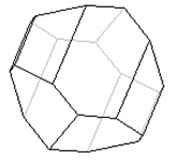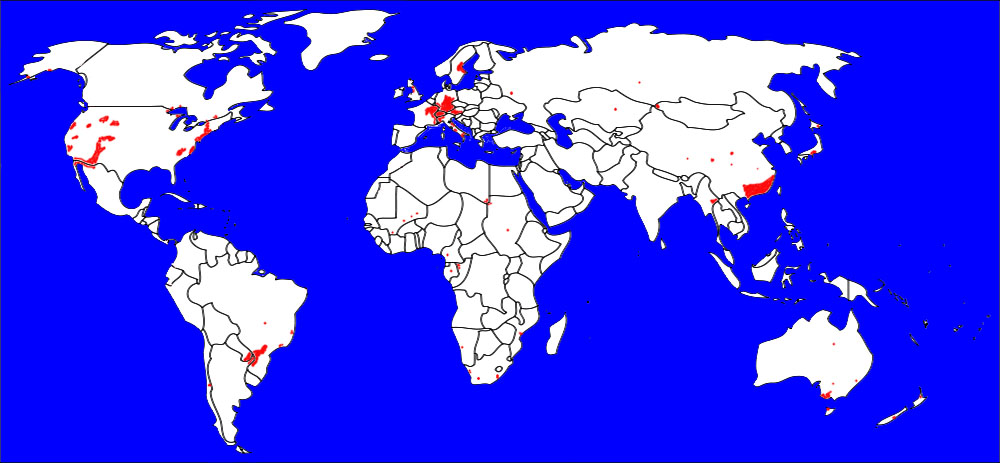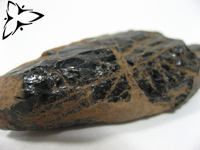![]()
Augite is a relatively common silicate mineral in the pyroxene group. Augite was named by Abraham G. Werner in 1792 from the Greek αυγή ("auge") for "shine" or "lustre," in allusion to the appearance of its cleavage surfaces. Occasional specimens have a shiny appearance that give rise to the mineral's name however; " ordinary specimens have a dull dark green, brown or black finish.
![]()
Within the metaphysical realm of minerals, augite can be used to enhance the understanding of metamorphosis in one's life. Augite can be used to ameliorate the more trying transformations. Purple Augite can be useful for providing guidance during spiritual growth. Brown Augite useful for clearing oneself of "muddy" emotional, spiritual, or physical issues. Streaked black Augite for healing painful transformations while allowing one to remain grounded and centered in reality.
Please note that MIROFOSS does not suggest in any way that minerals should be used in place of proper medical and psychological care. This information is provided here as a reference only.
![]() Augite is generally used in the manufacture of ceramics and for ceramic glazing materials.
Augite is generally used in the manufacture of ceramics and for ceramic glazing materials.
![]()
Augite is a major rock forming mineral and can be found in igneous, ultramafic and some some high grade metamorphic rocks.
![]()
Augite is a solid solution in the pyroxene group. Diopside and hedenbergite are important end members in augite. The calcium content of augite is limited by a miscibility gap between itself and pigeonite as well as orthopyroxene. When augite occurs with either of these other pyroxenes, the calcium content of augite is a function of temperature and pressure, but mostly of temperature, and so can be useful in reconstructing temperature histories of rocks. With declining temperature, augite may exsolve lamellae of pigeonite and/or orthopyroxene. There is also a miscibility gap between augite and omphacite, but this gap occurs at lower temperature and is not well understood.
Other than in the basic mineral form, augite can be found in six distinct varieties:
![]()
| Cleavage | Perfect | |
| Colour(s) | Brown green, Light brown, Dark brown, Black | |
| Specific Gravity | 3.40 | |
| Diaphaneity | Translucent to Opaque | |
| Fracture | Brittle - Conchoidal - Very brittle fracture producing small concoidal fragments | |
| Mohs Hardness | 5.0 to 6.5 | |
| Luminescence | Non-fluorescent | |
| Lustre | Vitreous to Resinous | |
| Streak | Greenish grey | |
| Habit(s) | Columnar to Granular to Massive | |
| Radioactivity | Non-radioactive | |
| Magnetism | Non-magnetic |
![]()
No known health risks have been associated with augite. However ingestion of augite, as with other naturally occurring minerals, is not recommended.
![]()
The following image shows the Elemental breakdown of the mineral augite along with the mineral crystal structure.

![]()
| Crystal System | Monoclinic |  |
| Class | Prismatic | |
| Axial Ratios | a : b : c = 1.0888 : 1 : 0,5833 | |
| Morphology | Stubby prismatic crystals | |
| Optical Data Type | Biaxial (+) | |
| Pleochroism (x) | Pale green, Pale Brown, Green | |
| Pleochroism (y) | Pink, Yellowish green | |
| Pleochroism (z) | Pale green, Grayish green, Violet |  |
| RL Values | nα = 1.680 - 1.735 nβ = 1.684 - 1.741 nγ = 1.706 - 1.774 | |
| 2V | Measured: 40° to 52°, Calculated: 48° to 68° | |
| Max Birefringence | δ = 0.026 - 0.039 (See colour chart at right) | |
| Surface Relief | High | |
| Dispersion | Weak to Distinct r > v |
![]()
Augite can be referenced in certain current and historical texts under the following five names:
The mineral augite can be translated into the following select languages:
| Arabic | الأوجايت | Bulgarian | Chinese (Sim) | 普通辉石 | |
| Croatian | Augit | Czech | Augit | Danish | |
| Dutch | Augiet | Esperanto | Aŭgito | Estonian | |
| Finnish | Augiitti | French | German | Augit | |
| Greek | Hebrew | אוגיט | Hungarian | Augit | |
| Italian | Japanese | 普通輝石 | Korean | ||
| Latin | Lithuanian | Augitas | Norwegian | ||
| Persian | Polish | Augit | Portuguese | ||
| Romanian | Russian | Авгитт | Slovak | Augie | |
| Spanish | Augita | Swedish | Augit | Tagalog | |
| Turkish | Ukrainian | Авгіт | Vietnamese |
![]()
Augite can be found in many places around the world. The map below shows major documented concentrations of augite:

![]()
 |
The MIROFOSS database offers free printable geological identification tags for personal and non-profit use. These tags can be used to properly identify mineral samples in your collection. -Click here- to download a full size jpeg image for an augite identification tag; which can be printed on paper or used with a plastic laser printer. |
 |
What's this? What can I do with it? |
![]()
| Chemical Composition | Hurlbut, Cornelius S.; Klein, Cornelis, 1985, Manual of Mineralogy, 20th ed., ISBN 0-471-80580-7 |
| Crystallography | Robinson, P., Ross, M., Nord, G.L., Smyth, J.R., and Jaffe, H.W. (1977) Exsolution lamellae in augite and pigeonite: fossil indicators of lattice parameters at high temperature and pressure. American Mineralogist: 62: 857-873. |
| Optical Data | Phillips, W.R. and D.T. Griffin (1981) Optical Mineralogy: 196-198. |
| History | Deer, Howie, and Zussmann (1997): 2A: 294-398. |
| Geographical Data | Mindat.org. Retrieved on 2012-02-01 |
| Physical Identification | Webmineral.com. Retrieved on 2012-02-01. |
| June 25, 2014 | The last time this page was updated |
| ©2017 MIROFOSS™ Foundation | |
 |
|






